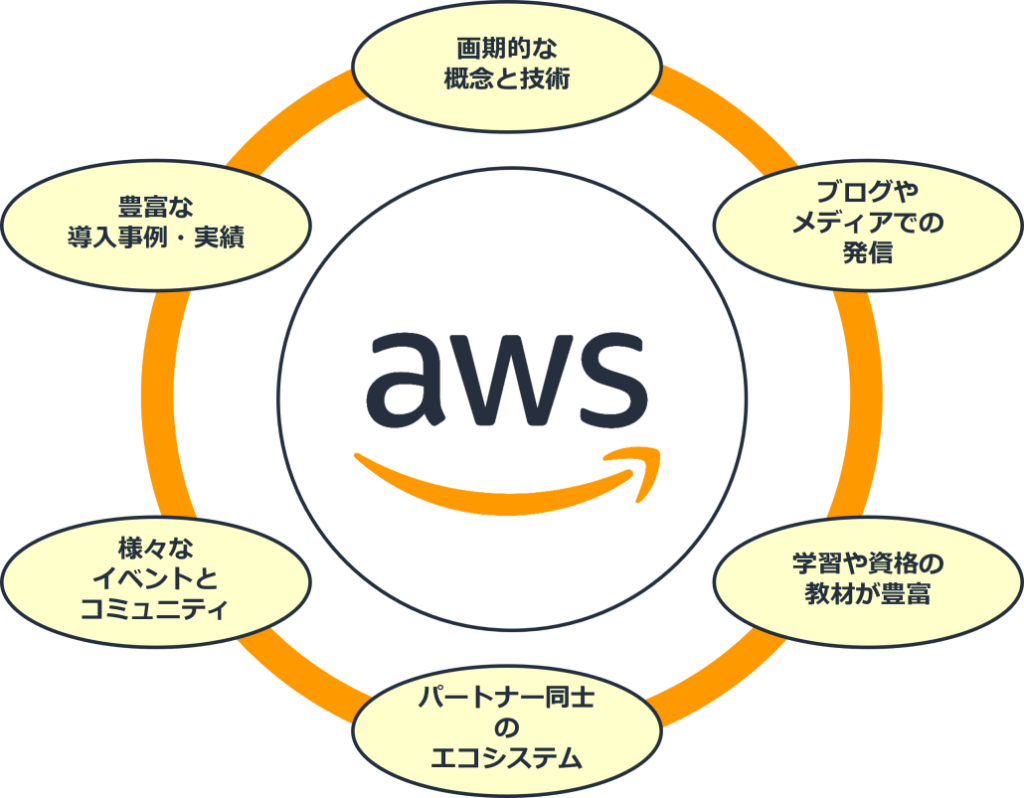[Consideration] Reasons why AWS has a high usage share and why it has become popular

table of contents
This is Ohara from the technical sales department.
Beyond is multi-cloud compatible, so we often work on projects and projects using various cloud environments other than AWS, such as Azure and GCP, but we have the best experience implementing projects and projects using AWS. There may be many.
AWS has a high usage share both in Japan and around the world, but the question is, "Why did AWS become so popular in the first place?" I think it will be difficult to maintain a top share simply because we have been providing groundbreaking infrastructure services since the early days of the concept of cloud computing.
In this article, we will discuss ``the reason why AWS has become so popular'', mainly from the perspective of Japan.
First, as data
Cloud server infrastructure share data
According to Publickey's article from around August 2023, AWS still ranks first in usage share. I don't know what the ranking will be in the future, but Azure's catching up is amazing.
https://www.publickey1.jp/blog/23/awsgoogle_cloud20232synergy_researchcanalys.html
Google Keyword Planner data
I used Keyword Planner to check the volume and prediction data for search keywords on the Google search engine for the period 2022.1 to 2023.11.
We tried to include similar keywords such as "cloud" and "server," but the keyword "AWS" had an overwhelmingly high search volume.
From this perspective, you can see that there are more opportunities to search for the keyword ``AWS'' than ``cloud.'' Therefore, it is generally safe to think that "cloud = AWS".

A time when there was no concept of cloud computing
A server environment is necessary to run systems and applications, but in an era where there was no concept of cloud computing like today, hosting services provided by data centers, server network hardware, It was common for companies to purchase software, install it in their own server racks, and run it on-premises (physically).
However, when using hosting or on-premises (physical servers), it can be difficult to size (advance estimate) the necessary server performance and capacity, assuming stable operation of systems and applications.
Depending on the stability of the system and applications, even if the performance and capacity of the server becomes insufficient, it may not be possible to prepare it immediately, so recovery from lost opportunities will be delayed, or conversely, if the performance or capacity of the server is excessive, it may become unnecessary. Upfront sizing was difficult, as it required extensive infrastructure costs.
In addition, if it is an on-premises (physical server), you must consider recovery from failures and failures due to aging hardware, and replacement of hardware when the manufacturer's maintenance for the hardware ends. yeah.
From an IT vendor's perspective, even if there is a project that requires on-premises (physical servers), depending on the business condition of the IT vendor, leases or credit for procuring servers may not be available, and the project itself may be affected. There were also cases where I was unable to participate.
Why AWS has become so popular
The reason why AWS has become so popular is that, as shown in the diagram above, these various elements, combinations, and continuous cycles have created a system that expands its popularity. .
Here, I will discuss this along with the author's personal opinion.
① Groundbreaking concepts and technologies
When using AWS cloud infrastructure, the concept of ``using only what you need, when you need it, without any initial costs'' was revolutionary.
AWS technology also improves the fault tolerance of applications running on that infrastructure by combining functions such as EC2, ELB, and Auto Scaling, and by using managed services such as S3 and RDS to improve system performance. AWS users can now freely build and configure their own infrastructure, such as increasing availability.
AWS manages the hardware such as servers and networks that make up the AWS architecture, so even if a failure or failure occurs on the hardware side, users do not need to maintain the hardware themselves. .
In addition, the business style of IT vendors and engineers has changed significantly, as it has become easier to build and configure infrastructure from outside or at home as long as you have a PC, an internet environment, and a credit card for payment. .
*By the way, I've heard that recently an increasing number of engineers say they've never seen an actual server hardware chassis.
② Dissemination through blogs and media
Even before AWS became popular in Japan, there were articles introducing IT services and technical information on blogs and media on the Internet. However, compared to the current situation, I don't think there was that much information available on the Internet, especially regarding infrastructure-related information such as servers and networks.
Before the advent of cloud infrastructure technologies such as AWS, even if you wanted to thoroughly learn about infrastructure-related things such as servers and networks, you had to work at an infrastructure company and gain experience to gain systematic knowledge and skills. It was difficult to learn, and it cost a lot of money to purchase the hardware for an individual to use, making it difficult to get started.
After that, with the advent of technologies like AWS, the advent of smartphones, the spread of SNS, and advances in web technology, companies and individuals alike have had more means and opportunities to transmit information over the Internet. . Also, if you have a PC and Internet environment, even individuals can easily connect to his AWS and design and build the overall infrastructure while testing it. Some people deepened their infrastructure-related knowledge and skills while studying at the university.
Along with this, I think the number of IT vendors and media outlets that publish infrastructure-related technology blogs has increased considerably since then. In particular, the volume of information related to AWS is overwhelmingly large compared to other companies' clouds.For example, if you want to find out about AWS, you can easily access various information about AWS. It's about time.
So, with so much information on the Internet, there are many opportunities to naturally catch your eye, so I think it's normal for engineers to want to try it out first.
③ Abundant learning and qualification materials
When learning AWS knowledge and skills, there are many learning materials such as AWS technology and certification books. Recently, there has been an increase in materials for learning other clouds, but AWS still tends to be more widely available.
For online learning, AWS Black Belt is the official AWS service, and online marketplaces Udemy and CloudLicense are often used, and there are a huge number of ways to systematically learn about AWS.
Even if you want to learn knowledge and technology about clouds other than AWS, you will often think based on AWS services. For example, if you had the opportunity to learn about a managed database like RDS on a cloud other than AWS, you would probably think, "Oh, something like RDS." (This is the same idea when it comes to projects and matters.)
The question ``Why is it that the abundance of learning and qualification materials leads to the spread of AWS?'' can be explained by the continuous cycle of A to D below. We believe that the increase in the number of people taking certifications is spurring an increase in the number of projects and projects using AWS.
・A: The environment is easy to learn because of the abundance of teaching materials and tools.
・B: Motivation increases because there are a wide variety of certification systems.
・C: You can advance your career by proving your skills with certifications etc. Leads to improvements
・D: I want to use the AWS I know for projects and projects
* From then on, the same cycle...
In addition, if you have a cloud-related qualification such as AWS, you may have an advantage in getting a job at an IT company, or the company you work for may provide you with a qualification bonus.
▼ Recommended books for studying AWS certification ▼
◇ AWS Certification Exam Text AWS Certified Cloud Practitioner
◇ AWS Certification Exam Text AWS Certified Solutions Architect - Associate
◇ AWS Certification Exam Text & Questions AWS Certified Solutions Architect - Professional
④ Ecosystem among partners
The AWS partner program and ecosystem is divided into various types, such as consulting partners and technology partners, to support companies and organizations that implement and utilize AWS. There are many IT vendors certified by AWS, so the number of AWS partners seems to be large compared to the number of other cloud partners.
This is largely due to the existence of ``mega partners'' who have been working together with AWS itself since the time when the concept of cloud computing first appeared, and who have been recognized for their high performance and technical capabilities. This mega-partner became the gold standard for his AWS cloud integration in Japan, and other IT vendors followed suit.
On the other hand, there were many IT vendors in Japan even before AWS became popular. This is thought to be due to the unique structure of the IT industry in Japan, and even now he has a strong influence with system integrators and his distributor (IT trading company). Since his system integration system (SIer) has already had many customers, it is thought that the synergistic effect with the aforementioned mega-partners has led to the spread of AWS.
However, AWS itself provides a large number of services (more than 200 types), so even if there are so many AWS partners, some projects and projects may be in areas in which the technology is weak, or work resources may be limited. There may be issues that cannot be addressed by one AWS partner alone. In such cases, the ecosystem of AWS partners is utilized, and partner companies may collaborate to carry out projects and projects.
There is also a system in which third-party companies that develop tools such as software and security publish the services they have developed on the AWS Marketplace, where they are sold as options when using AWS. , it becomes a factor that expands the network between partners.
By the way, most third-party companies first collaborate with AWS, publish and sell their products on AWS Marketplace, and after accumulating a track record there, they expand to other cloud marketplaces.
⑤ Various events and communities
AWS re:Invent and AWS Summit, which are held every year, are famous for the large-scale events officially held by AWS, but there are also other events with various AWS technology themes, such as AWS Dev Day and AWS Serverless Day. A conference is being held.
Through each event and conference, there are many opportunities for sharing the latest AWS information and best practices, technical sessions, and networking, so we have a mechanism to continually increase the number of users and fans who use AWS.
On the other hand, there is also an IT community called JAWS-UG (AWS Users Group – Japan), which is run by volunteers from AWS users and related parties. His AWS study sessions run by JAWS-UG are held regularly both online and offline, and the number of sessions held and the number of participants are among the highest in the Japanese IT community.
The JAWS-UG community is open to anyone who is interested in AWS, regardless of their level of knowledge or skill. The occupations of participants vary widely, including engineers, directors, marketing, sales, freelancers, and students.
At JAWS-UG, we mainly plan study sessions mainly for AWS users, speak at technical sessions, and present our AWS knowledge and techniques. By disseminating and sharing information from a user's perspective, it is also a place where users can express their unique views and interact with other AWS users.
I feel that the existence of JAWS-UG also played a major role in the spread of AWS in Japan. For example, even if only the employees who provide AWS (the so-called "inside people") communicate the appeal of the service, it will inevitably be viewed from the provider/manufacturer's side, and it will inevitably give off a sales atmosphere. It's not there.
However, JAWS-UG aims to ``disseminate and share AWS information from a user's perspective'' by repeatedly inputting and outputting information such as effective use of AWS, technical examples, and ideas among users who are actually using AWS. By doing so, we were able to gain sympathy from fellow AWS users who were also participating in the study group, and the key point was that we were able to appeal to our persuasive power.
By the way, the participants in the study session include not only IT vendors but also many engineers who belong to general companies. I believe that the engineers working at the company learned about cloud technologies such as AWS in order to develop internal systems in-house, and that the circle of exchange between engineers from various industries spread. .
⑥ Abundant implementation examples and track record
Nowadays, many people have probably heard of the term "AWS", even if they are not familiar with IT such as servers and cloud computing.
Even with such famous AWS, it seems that the spread of AWS did not go smoothly in Japan from the beginning. In Japan, IT vendors and system integrators have a strong influence, and there are also reactions from user companies such as ``Is this infrastructure originated overseas?'' ``Will my monthly bill change due to pay-as-you-go?'' ``What will I do if something happens?'' At the time, the situation was that ``only a few people who understood the benefits of AWS were using it.''
It was during this time that the Great East Japan Earthquake occurred in 2011. As a result of this earthquake, many companies lost their on-premises data centers and servers, making business continuity difficult. Even if local government servers and websites were safe, access was concentrated to gather information and connections became difficult.
Cloud computing such as AWS has been adopted to overcome this situation. Given this situation, it is impossible to prepare a new physical infrastructure right away, but by using the AWS infrastructure that exists in the cloud, you can immediately start restoring websites and systems. I was able to do that.
These series of events and examples have proven the convenience, scalability, and immediate effectiveness of using the cloud, and in 2011, the AWS Tokyo Region was opened. The adoption of AWS has rapidly expanded in Japan as well.
In addition, as the introduction of cloud services such as AWS continues to progress, the use of the cloud can improve affinity with websites that are only available for a limited time, such as campaign sites, and social games that may experience sudden spikes in access. The diversification of projects and matters that can be expected to increase has also progressed.
With AWS, there are many cases of implementation and achievements of this kind, regardless of the size of the company or organization. I think a kind of word-of-mouth cycle has been created.
summary
Above, we have considered the reasons why AWS has become so popular.
There is no doubt that the spread of AWS has brought about a game change in the IT industry.
Of course, there were various timings and turning points, but ultimately I feel that it was the result of a successful business scheme and marketing that aimed to get people to use AWS.

 10
10








